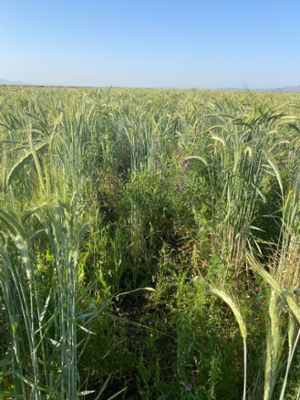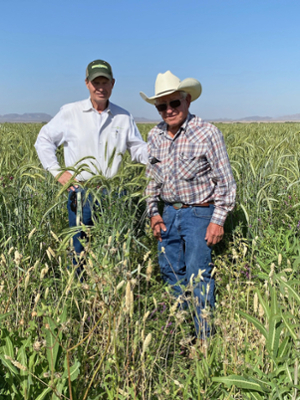CRARS Center
Exciting Work from The Center for Regenerative Agriculture and Resilient Systems
The Center for Regenerative Agriculture and Resilient Systems (CRARS) has been working to position itself as a research center and educational demonstration and training site, focused on programs that support farmers and ranchers in their transition to practices that improve soil health, carbon sequestration, and water use efficiency. Last year, we received a highly sought-after grant from the USDA National Institutes of Food and Agriculture (NIFA) Non-Land Grant Colleges of Agriculture (NLGCA) program to create a Climate-Smart Technical Service Training Program with the California Association of Resource Conservation Districts and other project partners. We also have been proceeding with several long-term research projects and one in particular has exciting preliminary results that we would like to share.

Climate-Smart Technical Service Training Program
The program was conceived as a comprehensive training program for agricultural professionals including Technical Service Providers (TSPs) in regenerative or climate-smart agriculture management. The goal is large-scale adoption through successful mobilization of a trained workforce available for conservation planning in areas such as grazing management, soil health management, pollinator habitat development, and carbon farm planning. As these conservation management plans come to fruition, producers can submit for “incentive” funding through the California Department of Food and Agriculture Health Soils Program or the Natural Resource Conservation Service Environmental Quality Incentive Programs.
The program consists of five elements, including a Professional Course Series through Chico State’s Professional & Continuing Education on Regenerative/Climate Smart Agriculture Management Systems. Classes include:
- Regenerative Agriculture Systems: Theory and Practice
- Soil Health Systems: Impacts of Management on Soil Health
- Science & Practice of Ecological Forest and Range Management
- Holistic Farm/Ranch Planning & Design
The program is designed to pair producers with technical service providers in the same educational program to receive training together on a systems-based approach to agriculture and conservation farm and ranch planning. The first cohort of four classes was completed online this past year and was well attended. However, producers in the program found themselves completely consumed by active engagement on their farm and ranching operations. So, while several farmers and ranchers did attend classes and are still very involved in the planning, the project has evolved to focus more on providing training to the TSPs and advisors. These new TSPs will have ongoing support through the Learning Collaborative in the form of a network of their peers, supported by the growers they serve.
The demand for trained TSPs has grown tremendously due to climate-induced weather incidents such as drought and other pressures. Currently, there are not enough providers to fill the need, so this is the appropriate target for the program. Service providers do still need to identify an agricultural operation to work with for their conservation plans, and those producers and others are still welcome and encouraged to participate to the extent they are able. Classes in the second cohort started in fall 2022 and will continue through the spring of 2023.
Improving Soil Carbon Capture and Water Use Efficiency in the Palo Verde Valley
CRARS is currently engaged in a five-year study with the Metropolitan (MET) Water District in the Palo Verde Valley. MET transports, stores, and distributes water to a large portion of southern California, including Los Angeles, Orange, Riverside, San Diego, San Bernardino, and Ventura Counties. The study is designed to increase their knowledge of regenerative agriculture and to identify carbon sequestration opportunities by comparing regenerative land management methods to current practices.
Alfalfa farmers in this region use tillage and conventional fallowing practices that leave the land bare between growing seasons. Their process involves multiple tractor passes, which add costs, increase emissions, and cause damage to soil structure. Wind and water erosion are a problem for these growers. In addition, the long-term drought has also forced MET to review all its production practices in light of water conservation efforts. Their preliminary assessments suggest the district is not saving as much water as it once thought with the current fallowing program.
Working together with a team from MET, Dale Tyson and Lyndon Ichita of HayDay Farms, we set up a study to contrast the current fallow program to a regenerative management system using year around living roots (cover crop) to condition the soil prior to the planting of alfalfa. The research is based on a randomized block design with three replications of two contrasting treatments. The first is a conventional fallow system with full tillage and no water application. The second is a regenerative fallow system including multiple species of winter and summer cover crops seeded with a no-till drill at 60# per acre, with minimal irrigation to maintain a living root system all year round. The regenerative fallow seeding began in October and November 2020. Once it was large enough, this fall cover crop was terminated with a roller crimper and a summer cover crop was planted in May and June 2021.

The preliminary results show differences in soil temperatures between the treatments and a significant shift in soil microbial communities, including about a six-fold increase in arbuscular mycorrhizal fungi in the cover cropped fields as compared to bare fallow. These changes in the soil microbial communities are necessary to begin the soil carbon accrual process. As soil carbon accumulates, the water infiltration and water holding capacity of the soil improve. These are encouraging results for the first year of a five-year project. The USDA has demonstrated that for every 1% increase in soil organic matter (which is primarily carbon), water-holding capacity increases by 25,000 gallons per acre. Watch our website for research updates.
Dale Tyson, the co-founder of HayDay Farms where this study is taking place, is excited about the results. He says the quality (tilth) of the soil is noticeably improved. It also eliminated about five to six tillage passages over the course of the study so far. Only a no-till drill has been used in the regenerative fields. Tyson recognizes that these fallowed fields, while left out of production, consume large quantities of water to “rehydrate” when brought back into production, and may take a couple of years to bring them back to normal productivity. He believes improvements to the existing fallowing program could improve his farm’s bottom line while enhancing water use efficiency at the same time.
